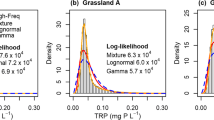Abstract
A numerical water quality criterion in the U.S. consists of three components representing magnitude, duration, and frequency. While magnitude and duration are well defined and conceptually unambiguous, the meaning of the frequency component is often debatable. We interpret the frequency component as a tool for accounting for uncertainty in estimating the mean concentration of a water quality constituent, after revisiting early works on environmental standards and criteria. Based on this interpretation, we illustrate management-related issues when using the default frequency of one exceedance in 3 years in compliance assessment. We propose a data-driven approach for estimating an appropriate frequency to ensure a consistent level of confidence in a water’s compliance of a water quality criterion. The data-driven frequency is determined by water quality constituent concentration distribution characteristics and sample size. The method is illustrated using two examples.


Similar content being viewed by others
References
Barnett V, O’Hagan A (1997) Setting environmental standards: the statistical approach to handling uncertainty and variation. Chapman and Hall, London
Bates DM (2010) lme4: mixed-effects modeling with R. Springer, New York. http://lme4.r-forge.r-project.org/book/
Chen J, Lu J (2014) Establishment of reference conditions for nutrients in an intensive agricultural watershed, Eastern China. Environ Sci Pollut Res 21(4):2496–2505
Cormier SM, Suter GW (2013) A method for deriving water-quality benchmarks using field data. Environ Toxicol Chem 32(2):255–262
Dodds WK, Oakes RM (2004) A technique for establishing reference nutrient concentrations across watersheds affected by humans. Limnol Oceanogr 2:333–341
Efron B, Morris C (1977) Stein’s paradox in statistics. Sci Am 236:119–127
Frey JW, Bell AH, Hambrook-Berkman JA, Lorenz DL (2011) Assessment of nutrient enrichment by ese of algal-, invertebrate-, and fish-community attributions in wadeable streams in ecoregions surrounding the Great Lakes. In: Scientific Investigations Report 2011–5009. National Water-Quality Assessment Program, U.S. Geological Survey, Reston, Virginia
Gelman A (2005) Analysis of variance—why it is more important than ever. Ann Stat 33(1):1–53 (with discussions)
Gelman A, Hill J (2007) Data analysis using regression and multilevel/hierarchical models. Cambridge University Press, New York
Gelman A, Hill J, Yajima M (2012) Why we (usually) don’t have to worry about multiple comparisons. J Res Educ Eff 5:189–211
Gibbons RD (2003) A statistical approach for performing water quality impairment assessment. J Am Water Resour Assoc 39(4):841–849
Guttorp P (2006) Setting environmental standards: a statistician’s perspective. Environ Geosci 13(4):261–266
Hutchens JJ, Chung K, Wallace JB (1998) Temporal variability of stream macroinvertebrate abundance and biomass following pesticide disturbance. J N Am Benthol Soc 17:518–534
McBride Graham B, Ellis Julian C (2001) Confidence of compliance: a Bayesian approach for percentile standards. Water Res 35(5):1117–1124
Ott WR (1995) Environmental statistics and data analysis. Lewis Publishers, Boca Raton
Qian SS (2010) Environmental and ecological statistics with R. Chapman and Hall/CRC Press, Boca Raton
Qian SS (2014) Statistics in ecology is for making a “principled” argument. Landsc Ecol 29(6):937–939
Smith EP, Ye K, Hughes C, Shabman L (2001) Statistical assessment of violations of water quality standards under section 303(d) of the clean water act. Environ Sci Technol 35(3):606–612
Smith EP, Zahran A, Mahmoud M, Ye K (2003) Evaluation of water quality using acceptance sampling by variables. Environmetrics 14:373–386
Smithson J (2007) West Virginia stream/river survey design 2007–2111. Technical report, West Virginia Department of Environmental Protection, Division of Water and Water Management, Charleston, WV 25304
Stephan CE, Mount DI, Hansen DJ, Gentile JR, Chapman GA, Brungs WA (1985) Guidelines for deriving numerical water quality criteria for the protection of aquatic organisms and their uses. Number 822R85100. US Environmental Protection Agency, Office of Research and Development, Cincinnati
U.S. EPA (1976) Quality criteria for water. U.S. Environmental Protection Agency. http://books.google.com/books?id=-sXHWGSvFS4C
U.S. EPA (1997) Guidelines for preparation of the comprehensive state water quality assessments. Technical report, Office of Water, U.S. Environmental Protection Agency, Washington, D.C.
U.S. EPA (1998) Clean water action plan: restoring and protecting america’s waters. Technical Report EPA 840R98001, US Environmental Protection Agency. http://yosemite.epa.gov/water/owrccatalog.nsf/e673c95b11602f2385256ae1007279fe/8cc8c2fd486f236a85256d83004fda6e!OpenDocument
U.S. EPA (2005) Guidance for 2006 assessment, listing and reporting requirements pursuant to sections 303(d), 305(b) and 314 of the Clean Water Act. Technical report, Watershed Branch, Assessment and Watershed Protection Division, Office of Wetland, Oceans and Watersheds, Office of Water, U.S. Environmental Protection Agency. http://water.epa.gov/lawsregs/lawsguidance/cwa/tmdl/upload/2006irg-report
U.S. EPA (2012a) Water quality standards for the State of Florida’s estuaries, coastal waters, and South Florida inland flowing watersowing waters. Federal Register, Volume 77, Number 243, EPA-HQ-OW-2010-0222; FLR-9759-3, 18 Dec 2012
U.S. EPA (2012b) Technical support document for U.S. EPA’s proposed rule for numerical nutrient criteria. http://www.regulations.gov/#!documentDetail;D=EPA-HQ-OW-2010-0222-0002, 30 Nov 2012
van Belle Gerald (2002) Statistical rules of thumb, 2nd edn. Wiley, Hoboken
Wallace JB, Vogel DS, Cuffney TF (1986) Recovery of a headwater stream from an insecticide induced community disturbance. J N Am Benthol Soc 5:115–126
WVDEP (2008) West Virginia integrated water quality monitoring and assessment report. Technical report, West Virginia Department of Environmental Protection, Charleston. http://www.dep.wv.gov/WWE/watershed/IR/Documents/IR_2008_Documents/WV_IR_2008_Supplements_Complete_Version_EPA_Approved
Ye K, Smith EP (2002) A Bayesian approach to evaluating site impairment. Environ Ecol Stat 9:379–392
Zhang Y, Huo S, Ma C, Xi B, Li X, Liu H (2014) Using stressor–response models to derive numeric nutrient criteria for lakes in the eastern plain ecoregion, china. CLEAN: Soil, Air, Water. ISSN 1863–0669. doi:10.1002/clen.201300708
Acknowledgments
The author thanks Craig Stow, Robert Miltner, Michael Paul, and Yoonkyung Cha for their insightful discussions and comments on an early version of the paper. We thank four reviewers and the associate editor for their constructive comments and suggestions. J. Frey and J. Bailey kindly provided the data used in the paper. Comments from S. Cormier are greatly appreciated.
Author information
Authors and Affiliations
Corresponding author
Electronic supplementary material
Below is the link to the electronic supplementary material.
Rights and permissions
About this article
Cite this article
Qian, S.S. The Frequency Component of Water Quality Criterion Compliance Assessment Should be Data Driven. Environmental Management 56, 24–33 (2015). https://doi.org/10.1007/s00267-015-0493-1
Received:
Accepted:
Published:
Issue Date:
DOI: https://doi.org/10.1007/s00267-015-0493-1




